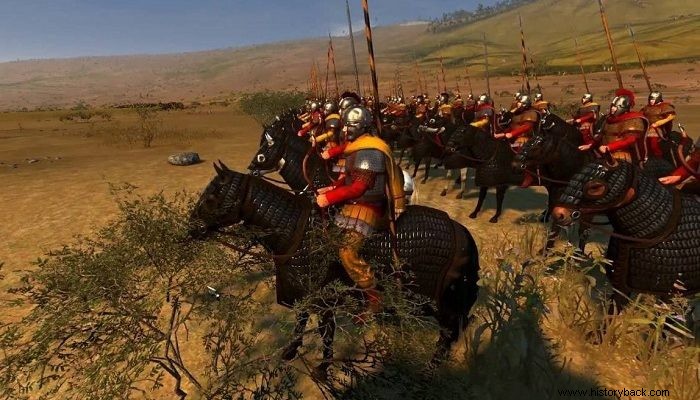
Inspired by the martial art of the Empire's two main rivals at the time, the Germans and the nomads of the East, the eminent general Belisarius conceived the idea of finding the antidote, which was none other than the dual-role cavalry .
The new cavalry he intended to assemble had to have sufficient agility and firepower to withstand the onslaught of the dreaded German heavy cavalry, and enough cohesion to easily deal with the disorderly but impetuous attacks of the Oriental horse archers. These horsemen were called bucellari – the bucella was a type of galette. The men who shared the same bread, that is, the fellow-bankers, initially formed a single small bodyguard division of Belisarius, in which all his friends were assigned.
Their difference from the common cavalry, the so-called cavaliers, was that the buccalarians were equipped with lance and bow and were able to fight both in dense order, making advances like the heavy cavalry, but also in a strafing formation, avoiding heavier opponents and overwhelming them with their arrows.
Against the Germans
When Belisarius was convinced that his men were ready for battle he asked the emperor to allow him to go with his battalion to the northern frontier, to test the battalion in real combat conditions, fighting against the German Gepids. So Belisarius, at the head of his 250 buccals, reached the Danube and immediately took action. The Gepids, like most Germans, except the Franks, had, under the influence of the Huns, become excellent horsemen. Their infantry was not remarkable.
However, the German cavalry was elite and especially after the battle of Adrianople it caused terror to the Byzantines . He was noted for his impetuosity, but not for his discipline and consistency. The Gepids lived in groups, known as "gau", on the north bank of the Danube, which formed the border of the Empire. From there they often crossed the river and carried out raids at great depth.
Belisarius encamped with his men in a region where there was neither city nor village nearby. This he did to accustom his men to deprivation. A ship had moored on the south bank of the Danube, which was their forward base, on which were small stores of food, stores of arrows, and a workshop of blacksmiths to carry out repairs to the armament.
The chaplains would visit the ship – every 10 days as needed. Otherwise they would live on supplies captured by the enemies. Belisarius, having studied the battle tactics of the Gepids, ordered his men not to engage with them until the enemy had been disorganized by the losses their arrows would have caused them. The buccalarians would deploy in a strafing formation, constantly harassing the Gepid horsemen with shots, attempting to force them to retreat, abandoning their infantry.
In this way the Gepid horsemen would be deprived of the protection of their friendly infantry and would be easily dealt with by the Byzantine buccalarians. The men, under his watchful guidance, did indeed follow his orders to the letter. For about four months, Belisarius' 250 buccalarians operated in an area where 20 times more enemies were active, without being defeated by them, causing them significant losses and capturing several. Belisarius in these battles had only three wounded and one dead, but he was not lost as a result of enemy action, but by accident - he drowned.
